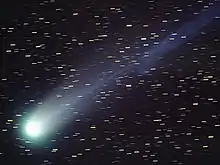 Comet 31P/Schwassmann-Wachmann observed on February 14, 2011 | |
| Discovery | |
|---|---|
| Discovered by | Arnold Schwassmann Arno Arthur Wachmann |
| Discovery date | January 17, 1929 |
| Designations | |
| 1929 I; 1935 III; 1942 I; 1948 VII; 1955 I; 1961 VII; 1968 II; 1974 XIII; 1981 VI; 1987 XIX; 1994 II | |
| Orbital characteristics | |
| Epoch | March 6, 2006 |
| Aphelion | 5.048 AU |
| Perihelion | 3.416 AU |
| Semi-major axis | 4.232 AU |
| Eccentricity | 0.1928 |
| Orbital period | 8.705 a |
| Inclination | 4.5487° |
| Last perihelion | July 6, 2019 September 29, 2010[1] January 18, 2002[1] |
| Next perihelion | 2028-03-19[2] |
31P/Schwassmann–Wachmann, also known as Schwassmann–Wachmann 2, is a periodic comet in the Solar System. It was discovered on January 17, 1929, at an apparent magnitude of 11.[3] The comet has been seen at every apparition.
The comet nucleus is estimated to be 6.2 kilometers in diameter.[4] In 1929, the astronomer Anne Sewell Young identified the comet with an object that had been misidentified as the minor planet "Adelaide" (A904 EB).[5]
References
- 1 2 Seiichi Yoshida (2008-10-26). "31P/Schwassmann-Wachmann 2". Seiichi Yoshida's Comet Catalog. Retrieved 2010-01-24.
- ↑ "31P/Schwassmann-Wachmann Orbit". Minor Planet Center. Retrieved 2020-06-29.
- ↑ Kronk, Gary W. "31P/Schwassmann–Wachmann 2". Retrieved 2010-01-24. (Cometography Home Page)
- ↑ "JPL Small-Body Database Browser: 31P/Schwassmann–Wachmann 2" (2010-01-21 last obs). Jet Propulsion Laboratory. Retrieved 2010-02-26.
- ↑ "Long 'Lost' Planet Found Masquerading as Comet". Oakland Tribune. June 21, 1929. p. 31. Retrieved November 9, 2017 – via Newspapers.com.

External links
- Orbital simulation from JPL (Java) / Horizons Ephemeris
- 31P at Kazuo Kinoshita's Comets
- 31P/Schwassmann-Wachmann 2 – Seiichi Yoshida @ aerith.net
This article is issued from Wikipedia. The text is licensed under Creative Commons - Attribution - Sharealike. Additional terms may apply for the media files.

.png.webp)